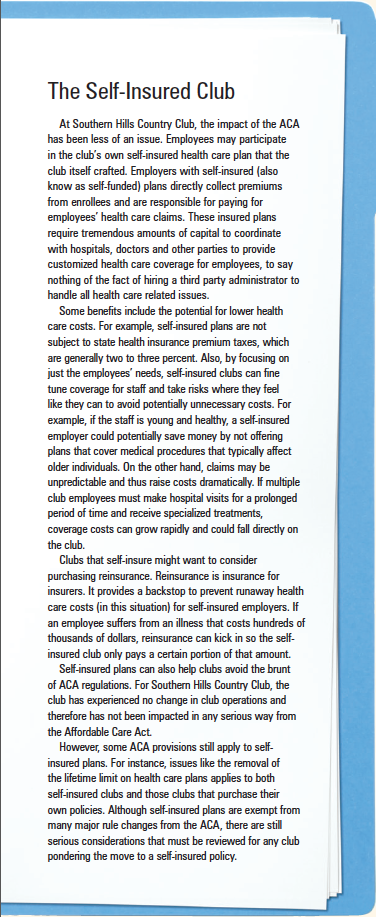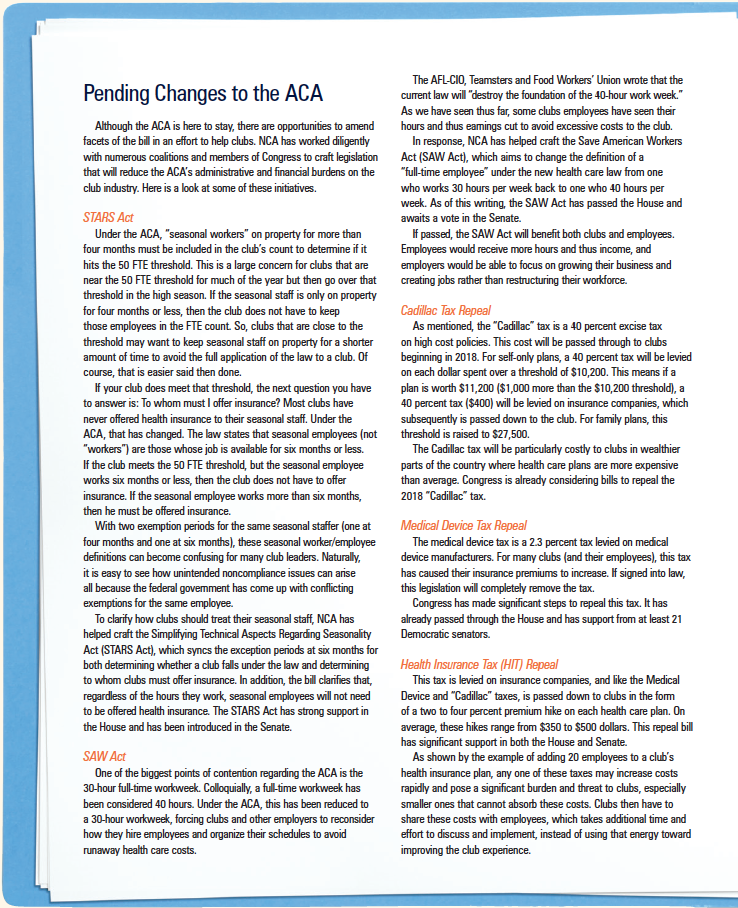The Affordable Care Act (ACA) is here to stay and clubs must comply with it. Signed into law in March 2010, the ACA has survived numerous challenges and repeal votes, and after June’s King v. Burwell Supreme Court decision, it’s unlikely that any major changes will occur in the near future. Clubs are making adjustments to comply with the ACA, and more changes to club operations are sure to come.
To keep the industry up to date on how the ACA is impacting clubs, NCA has interviewed general managers from five leading clubs to learn how each has adapted health care offerings, and what challenges, operational issues and governance and staffing issues arose during the implementation phase.
Those interviewed include Phil Iannelli, GM/COO, Wilmington Country Club; Albert Costantini, GM/COO, Canoe Brook Country Club; Luke O’Boyle, GM/COO, Chevy Chase Club; Nick Sidorakis, GM/COO, Southern Hills Country Club; and Mark Bado GM/COO, The Kansas City Country Club. Each of these clubs has more than 100 full-time employees (FTEs), more than 30 part-time employees and more than 30 seasonal employees. Each of these clubs provides employee, spousal and dependent health care benefits. All respondents have already begun offering health insurance to their employees in compliance with the ACA.
The ACA Comes at a Cost
Every club has been impacted by the ACA in one form or another, whether through increased planning, documenting and reporting, or implementing its many regulations. Each of these processes takes time, money and effort, and across the board, NCA’s interviewees considered taking measures to mitigate the increased burdens from the ACA.
Employees
In implementing recent changes to their plans, some of the clubs shifted a portion of costs to their employees. All but one indicated that their club considered reducing part-time workers’ hours to below the 30-hour per week threshold to minimize the number of employees who must be offered insurance. Each respondent also indicated that their club considered increasing the employees’ contribution amount for health insurance to lower costs. All respondents said that they considered reducing the actuarial value of their club’s health insurance plans to cut costs, such as changing from a 90/10 coverage plan to a 70/30 plan. Spouses and dependents on staff health coverage options remained a part of the offered plans.
Part-Time Staff
The respondents were less unified when it came to employees who work between 30 and 39 hours per week. Under the ACA, the 30-hour per week threshold is critical as it defines what is considered a FTE versus a part-time employee. If a club has more than 50 FTEs, the ACA requires the club to offer FTEs a health care plan in 2016 (clubs must provide plans in 2015 if they have more than 100 FTEs), but does not require a club to offer a plan to those who work less than 30 hours each week. Three of the clubs indicated that they maintained the same hours for those who work between 30 to 39 hours each week. At one club, hours were reduced to below the 30-hour threshold for some part-time employees and kept the same for other employees, while another reduced their part-time workers’ hours to below the 30-hour threshold. All clubs were able to keep their premium contributions the same.

 Wilmington Country Club has created two categories of workers who receive health care to help simplify and cut down on costs of their benefits packages: those who receive just health insurance without other employee benefits, and those who receive full employee benefits.
Wilmington Country Club has created two categories of workers who receive health care to help simplify and cut down on costs of their benefits packages: those who receive just health insurance without other employee benefits, and those who receive full employee benefits.
The ACA also provides a “look-back” period for clubs to determine whether their employees work 30 or more hours each week and therefore determine whether the employee is considered full-time or part-time. Clubs can “look back” at their employees’ hours from three to 12 months prior, creating additional administrative challenges. Four of the five respondents indicated that they optioned to “look back” 12 months. At Wilmington Country Club this process posed challenges to department managers to justify and control the schedules for certain employees.
Seasonal Employees
The ACA has changed rules related to seasonal employees and has forced clubs to change their policies. Under the ACA, seasonal employees are considered as such if they work six months or less. If they work full-time for more than six months, they must be offered health insurance. Each club except for The Kansas City Country Club kept the same number of seasonable employees and the same amount of time they are employed at the club as in years past. The Kansas City Country Club determined that the club would have to cut back on both items to keep costs down. At Chevy Chase Club, a new category of employees was created for those who work more than six months at the club, but less than a full year. These employees include golf professionals, golf maintenance employees and tennis professionals. This category is similar to Wilmington Country Club’s categories, as these employees are now eligible for health care coverage but are not considered for other fulltime employee benefits.
Most Difficult ACA Staffing Challenge
The most difficult aspects for staffing and personnel varied among those interviewed. For the Chevy Chase Club, cutting hours and considering an increase in employee contributions for health care premiums proved to be most difficult. The Kansas City Country Club pointed to the administrative concerns regarding tracking hours for all staff to ensure employees’ hours are below the 30-hour threshold and handling seasonal employees. Canoe Brook Country Club was able to keep the same wages and hours for both seasonal and part-time employees.
Wilmington Country Club noted the challenge of increased costs, since they had several employees under their old threshold for benefits who now fall under the new hourly definition and must be provided health care benefits. The club contributes $6,000 toward employees’ annual health care plans—an increase of approximately 25 percent to their employment cost. This now means employees who were earning $20,000 per year are at a $26,000 level even though the job classification may not be valued at that higher level.
These costs can add up quickly. For example, a club like Wilmington Country Club that contributes $6,000 toward each employee’s health care plan may see its costs rapidly rise into the tens of thousands of dollars, if not more. With the full-time threshold lowered to 30-hours a week, clubs often must add 10, 20 or more employees to their health care plans to comply with the ACA. Altogether, a club that adds 20 employees to its health care plan and contributes $6,000 to each employee’s plan will incur an additional $120,000 in annual costs. This is the equivalent of three mid-level employees.
Finances and Operations
The ACA has increased financial and operational burdens in other areas as well. Canoe Brook Country Club noted the potential increase in costs due to the ACA’s “Cadillac” tax as a concern. Set for implementation in 2018, this 40 percent excise tax is nondeductible and will be levied on employer-sponsored health coverage that provides high-cost premiums.
Chevy Chase Club’s cost increase came from adding 20 new eligible employees to the club’s health care plan as they surpassed the 30-hour per week threshold. New rules and recordkeeping regulations are too time consuming and forced Wilmington Country Club to outsource its payroll. The Kansas City Country Club found the processes of studying the ACA and understanding and implementing it were most financially demanding.
The ACA poses a significant burden to clubs. Clubs have absorbed much of the new costs, but have also called on their employees to shoulder some of them as well. At least three of the clubs considered whether it was more prudent to continue offering insurance at all or pay the government’s $2,000 fine for each FTE. Although their clubs did not go through with it, the financial impact from the ACA makes considerations like this a real possibility.
The Board
Although boards do not typically handle the details of staffing, such as work schedules and hires, they do play a large role in planning the budget and have a fiduciary responsibility to operate the club efficiently and effectively. Often, boards are made up of business owners, lawyers and other professional who have strong business acumen and also have been impacted by the ACA.
Thus, boards may have a say in how the club should handle ACA implementation as well. The boards of the GMs interviewed understood that compliance was a top priority. At Wilmington Country Club the board had already recognized the club’s challenge because most board members were also experiencing the same difficulties in their own lives and businesses. Their board was notified that the club’s benefit cost would increase to comply with the ACA. Other boards understood the advantages and disadvantages of the ACA, and others relied on the staff to manage the law’s impact.
The Best Part of the ACA
The ACA has thrown many obstacles in the ways of GMs, but it has also provided several key benefits to clubs. The ACA has given some clubs the opportunity to review their seasonal workers practices. At Wilmington Country Club it changed their philosophy in providing health care to employees by opening up more options for them. Now Wilmington Country Club employees receive five health care options with the club providing a fixed level of financial contribution. Employees select a plan that best fits their budget and health care need. Any increase in employee contribution is recognized as a result of the ACA and/or their individual choice. The Kansas City Country Club saw the broader benefits of the ACA’s mandatory and preventive attributes, such as pediatric care, maternity and newborn care and others.
The Worst Part of the ACA
Almost unanimously, the most difficult aspect of the ACA (so far) has been the onslaught of new rules and regulations to learn, understand and implement. There are more than 20,000 pages in the legislation, according to the Obama administration’s own estimates, which pose tremendous challenges to clubs, especially smaller clubs that cannot shoulder increased costs.
ACA Impact
In 2010, President Obama signed the ACA into law despite staunch opposition. Today, that opposition has not gone away while clubs now struggle with complying with its mandates. Responses from leading clubs interviewed for this article revealed a wide range of changes that clubs have made, from small to no changes in some instances to significant changes such as releasing employees, creating new categories of health care plans and devoting large amounts of time and resources to new administrative functions. Hopefully these leaders’ responses provide a valuable frame of reference for how your club should respond to its own ACA issues.

Phillip Mike is NCA’s communications manager.



